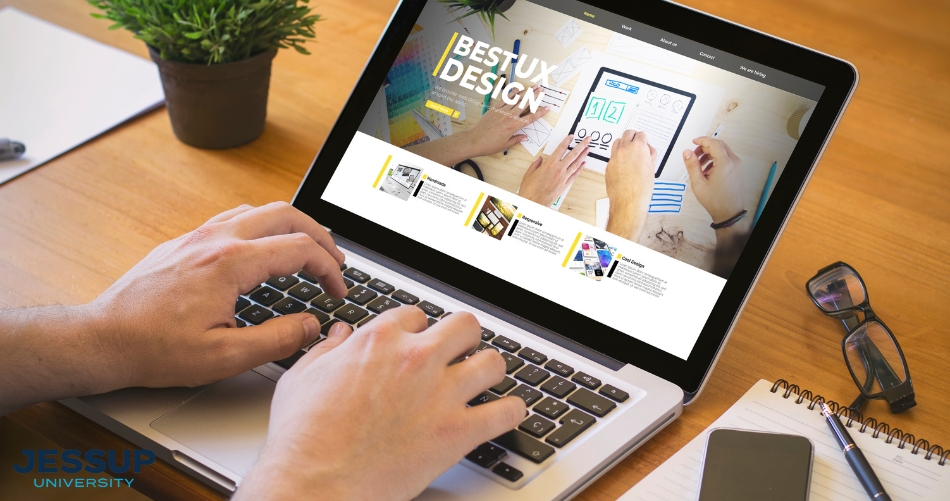Web Design London Ontario with SEO and Mobile-Friendly Features
Web Design London Ontario with SEO and Mobile-Friendly Features
Blog Article
How to Efficiently Combine Aesthetics and Performance in Internet Layout
When making a website, you need to strike a balance between looks and capability. It's not simply about looking great; your style must additionally offer a purpose and guide users efficiently. By concentrating on simpleness and instinctive navigation, you can produce an engaging experience. But what elements genuinely enhance use while keeping visual appeal? Allow's discover the vital concepts that can lead to a harmonious mix of charm and function.
Recognizing the Importance of Aesthetics and Performance
Understanding the equilibrium in between appearances and functionality is necessary for developing a reliable individual experience when you make a site. A visually attractive website grabs attention, however it's the performance that keeps individuals engaged. Site visitors will promptly lose passion and leave.Consider your target audience and what attracts them in if your website looks wonderful yet is tough to navigate. You wish to create a layout that reflects your brand name while guaranteeing ease of use. Structured layouts, intuitive navigating, and clear contact us to action can enhance both visual appeals and performance.

Concepts of Reliable Internet Style
To create an efficient website design, you need to comply with numerous crucial principles that enhance both customer experience and aesthetic charm. First, prioritize simpleness; a tidy format assists individuals browse quickly. Utilize a consistent color pattern and typography to maintain coherence across your site. This fosters familiarity and trust.Next, ensure your style is receptive. Individuals access web sites on different gadgets, so your style ought to adapt flawlessly. Take notice of visual hierarchy; emphasize essential components with size, shade, or positioning to direct customers' focus.Finally, include ample white space. It prevents clutter and makes material more absorbable. Keep in mind, effective website design equilibriums looks and performance, so every design choice need to serve a function. By following these concepts, you'll develop a site that's not only visually attractive however likewise straightforward, inevitably keeping visitors engaged and encouraging them to return.
Prioritizing Customer Experience
When prioritizing individual experience, you'll wish to begin by recognizing what your users absolutely require. Streamlining navigation layout can make a substantial distinction in just how conveniently they find what they're trying to find. Enhancing visual pecking order helps lead their focus to the most vital aspects on your website.
Comprehending User Requirements
Recognizing user needs is vital for creating an appealing internet experience that maintains visitors coming back. To achieve this, you must determine the objectives and preferences of your target market. Beginning by conducting user study, like surveys or meetings, to gather understandings on what users value most. When engaging with comparable internet sites, pay attention to their pain factors and obstacles. This info enables you to tailor your style, making sure capability straightens with individual assumptions. In addition, take into consideration producing individual characters that represent various segments of your target market, helping you envision their requirements throughout the style procedure. When you prioritize recognizing individual requirements, you develop a website that not only looks wonderful however additionally supplies a seamless, pleasurable experience that fosters loyalty.
Streamlining Navigation Style

Enhancing Visual Hierarchy
A strong visual pecking order is necessary in leading individuals with your website and ensuring they involve with key content. To achieve this, make use of color, spacing, and dimension tactically. Make crucial components like headings bigger and bolder than body message, drawing attention quickly. Make use of contrasting colors to highlight phone call to action, motivating clicks. Furthermore, use sufficient white space to different sections, making content digestible and inviting.Consider the flow of details; organize elements practically, leading users' eyes from one point to the following. Usage aesthetic signs, like arrows or lines, to direct attention. By prioritizing aesthetic pecking order, you enhance user experience and increase the probability of conversions, ensuring your internet site is both aesthetically pleasing and functionally effective.
Shade Concept and Its Effect On Usability
While choosing the best colors for your internet site may feel like a minor detail, it greatly influences use and user experience. Shade influences how individuals regard information and can improve or prevent navigating. For instance, contrasting colors can assist vital elements stick out, making it easier for visitors to discover what they need.Additionally, take into consideration the psychology of colors: blue typically motivates trust, while red produces seriousness. Knowing your target audience can direct your shade selections, ensuring they reverberate well.Moreover, constant color design aid construct brand name identification, making your internet site a lot more unforgettable. However, beware-- way too many shades can overwhelm individuals. Stick to a limited palette that complements your content and maintains clarity.Incorporating accessibility is also important; verify your color mixes get along for those with aesthetic disabilities. By thoughtfully applying shade concept, you'll improve usability and create an extra appealing individual experience.
Typography: Balancing Design and Readability
Shade options set the phase for your web site, however typography plays an equally essential duty in improving individual experience. You want your message to interact clearly while additionally showing your brand's individuality. Beginning by choosing fonts that are not just appealing but additionally clear. Sans-serif fonts usually function well for digital displays, as they're simpler to review at numerous sizes.Maintain a pecking order by using different font style sizes and weights; this guides customers via your material effortlessly. Take into consideration line spacing and letter spacing; as well tight can discourage visitors, while as well loosened can interrupt the circulation. Limitation your typeface options to 2 or three to maintain the style cohesive.Finally, constantly evaluate your typography throughout different devices and internet browsers. What looks good on one display might not on another. Stabilizing style with readability guarantees that your message resonates, maintaining your audience engaged and educated.
Receptive Design: Making Aesthetic Appeals Work on All Devices
To assure your site looks great on any type of tool, you'll require to embrace responsive style concepts. This approach guarantees your site adapts to numerous display dimensions, offering an ideal individual experience. Beginning by making use of fluid grids and flexible pictures that scale effortlessly. Rather of fixed dimensions, opt for portions and family member systems, permitting your format to readjust dynamically.Next, implement media queries in your CSS. These let you apply different styles based on device qualities, like screen size. This method, you can keep visual charm while ensuring functionality.Don' t neglect concerning touch targets; make particular switches and web links are simple to tap on smaller screens. Prioritize important content, so users can easily navigate your website no matter of their gadget. By concentrating on these aspects, you'll create an engaging, visually appealing experience that fulfills the demands of all individuals, whether they're on a desktop, tablet computer, or mobile phone.
Carrying Out Usability Screening for Constant Improvement
To enhance your website design, you need to establish clear functionality goals that straighten with customer requirements. By conducting customer tests, you can gather beneficial comments on exactly how real individuals communicate with your site. Assessing these results will certainly assist you make informed renovations and develop a more efficient user experience.
Specifying Functionality Goals
While looks can draw customers in, defining use goals is essential for guaranteeing their experience remains enjoyable and seamless. Beginning by identifying what you desire users to accomplish on your website (website design london Ontario). Consider their requirements, jobs, and behaviors. Are they seeking information, buying, or registering for a newsletter? Develop clear standards to measure success, like job conclusion prices or time on task. Prioritize instinctive navigating, available material, and responsive design to improve use. Frequently take another look at these goals as individual assumptions advance. By defining usability goals, you produce a structure for reviewing and improving your site's efficiency. This emphasis on use not just enhances user fulfillment yet also strengthens the total performance of your design
Carrying Out Individual Tests
Carrying out customer examinations is crucial for refining your website and ensuring it satisfies your audience's requirements. Begin by determining your target customers and developing an examination strategy that details your goals. Utilize a mix of qualitative and measurable methods, such as studies, meetings, and task-based monitorings, to gather extensive comments. Invite individuals to browse your website while you observe their interactions and keep in mind any type of problems they come across. Motivate open dialogue to capture their ideas and sensations regarding the design and functionality. Maintain sessions brief and focused, ensuring you cover vital locations without overwhelming users. Ultimately, see to it to document all findings, here as this details will be indispensable for making informed layout choices that enhance both visual appeals and usability.
Examining Test Outcomes
How can you properly examine the results of your functionality tests to drive constant improvement? Beginning by categorizing responses into typical themes. Try to find patterns in user actions that highlight pain factors or areas for improvement. Use measurable data, like task conclusion rates and time on job, to measure use objectively. Do not fail to remember to think about qualitative insights from user comments; they often expose underlying issues that numbers can not reveal. Prioritize one of the most impactful findings and produce actionable products for your layout team. Remember, it's concerning iterating-- carry out changes, then examination again. This cycle of screening, evaluating, and refining aids you balance appearances and functionality, guaranteeing your website satisfies individual demands efficiently while keeping visual appeal.
Frequently Asked Concerns
Just how Do I Pick the Right Shade Palette for My Website?
To select the ideal shade scheme for your internet site, consider your brand's character, target audience, and psychological influence (website design london Ontario). Usage shade psychology, develop consistency, and guarantee readability. Test combinations to see what resonates best with visitors
What Devices Can Help With Website Design Aesthetic Appeals and Capability?
You can make use of devices like Adobe XD, Figma, and Map out to improve your web style's aesthetic appeals and performance. These platforms provide user-friendly interfaces, partnership functions, and pre-made design templates to improve your creative process and improve your layouts.
Just How Can I Include Animations Without Jeopardizing Performance?
To incorporate animations without endangering capability, focus on subtle effects that boost customer experience. Usage CSS animations for smoother interactions, guarantee fast tons times, and test on various tools to preserve performance while including aesthetic charm.
What Prevail Mistakes to Stay Clear Of in Website Design Looks?
When creating, prevent cluttered layouts, inadequate shade choices, and irregular font styles. Don't forget mobile responsiveness, as it can push away users. Validate your style aligns with your brand name, producing a seamless experience that involves visitors efficiently.
How Often Should I Update My Internet site's Style for Optimum Appearances?
You need to update your website's style every 1-2 years to stay on top of fads and preserve perfect aesthetics. Consistently renewing visuals assists engage assurances and visitors your site remains enticing and user-friendly. When you make a website, recognizing the balance between appearances and performance is necessary for creating an efficient individual experience. To develop an effective web layout, you require to stick to several essential concepts that boost both user experience and visual charm. Customers accessibility websites on different gadgets, so your style needs to adjust seamlessly. When prioritizing individual experience, you'll desire to begin by recognizing what your customers truly need. Start by carrying out individual study, like meetings or studies, to collect understandings on what customers worth most.
Report this page